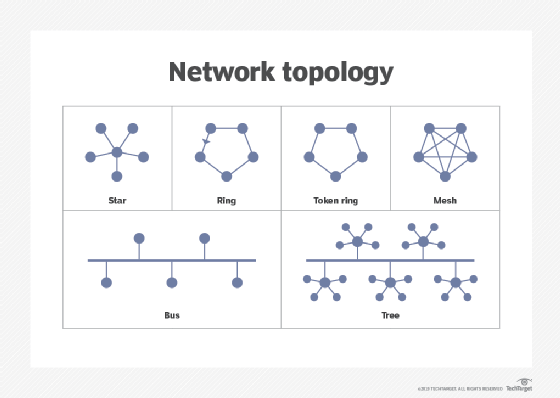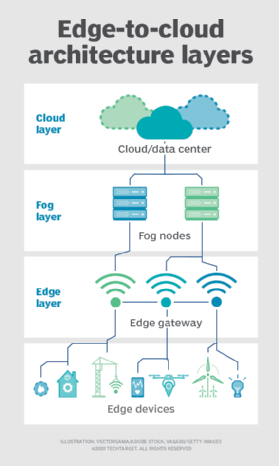network node
What is a computer network and where do network nodes fit in?
A computer network is a system of computers and computing devices that are connected via communication links. These links allow the computers and other devices to send information over the network.
Network protocols define how information is sent and received. Networks can be defined by their geographic location, the protocols they use, the physical arrangement of the network components and their purpose.
Computer networks can be physical or logical. A physical computer network is a real network comprised of the cable and devices that send data back and forth. Logical networks are software representations of a physical network. They are built on top of a physical network.
Computer networks aim to share information and resources among multiple digital devices. The internet is an example of a computer network. It is made up of many smaller computer networks. Computer networks make things like video streaming, social networks and cloud networks possible.
A network node is a connection point in a communications network. Each node is an endpoint for data transmissions or redistribution. Nodes have either a programmed or engineered capability to recognize, process and forward transmissions to other network nodes.
The concept of network nodes came into being with the use of distributed networks and packet switching. Depending on the application, network nodes perform a variety of functions.
What does a network node do?
A network node sits at a point in the network where it sends, receives, stores or creates information. It transmits data to communicate with other nodes in the network.
In a computer network, nodes can be physical networked devices, such as modems, PCs and printers. These devices recognize transmissions from other nodes and forward them to other nodes. A node checks for identification, such as an IP address, to grant access to the node.
Nodes connect over a link or communication channel. In a computer network these may be cable, fiber optic or wireless connections.
What are the types of network nodes?
There are several ways to categorize nodes. One way is by network type; another is by network topology.
Network type
- Data communications. In data communications, physical network nodes include data communications equipment or devices that sit between data terminal equipment (DTE) and data transmission circuits. These include switches, bridges, modems or hubs that perform signal conversion, coding and line clocking. These nodes also include DTE, such as digital telephone handsets, printers, routers, servers and workstations.
- Internet network. On the internet and with intranets, most physical network nodes are host computers identified by an IP address. However, some data link devices, such as wireless local area network (LAN) access points, do not have IP host addresses. They are considered physical network or LAN nodes rather than internet nodes or hosts.
- LANs and wide area networks. These nodes are devices that perform a specific function. Each one must have a Media Access Control address for each network interface card. Examples include modems with Ethernet interfaces, wireless LAN access points and computers.
- Telecommunications network. In fixed telephone networks, nodes may be public or private telephone exchanges or a computer providing an intelligent network service. In cellular communications, nodes include base station controllers that control one or more base stations. Cellular network base stations are not considered nodes.
- Cable system. In cable systems, nodes use fiber optic cable to connect to businesses and homes served by a common fiber optic receiver within a geographic location. A fiber optic node describes the number of homes or businesses that a specific fiber node can serve.

Network topologies
Another way to categorize nodes is by how they are arranged in a physical computer network. This is known as the network topology approach. Some common network topologies include these four:
- Bus topology connects individual nodes directly to a main cable.
- Ring topology has nodes connected in a loop or ring; each node has a neighbor on each side.
- Star topology connects all nodes to a central hub.
- Mesh topology has every node connected to every other node.
What are examples and applications of network nodes?
Examples of how network nodes are used include the following:
Print request. An employee sends a print request from a computer to a printer located in another part of the office. The employee's computer is a node on the network. The request travels over the network and through a series of other nodes -- a router, for example -- on the company LAN. The request reaches the printer, also a node; it processes the request and completes the printing job.

Base station controller. This is a node on a cellular network that provides intelligent network services to devices. The base station controller sits between the cell sites and mobile switching center, which are also nodes on the cell network. Base station controllers determine how cell signals should be routed through the network.
Peer-to-peer mesh network. A peer-to-peer mesh network lets mobile devices communicate information without Wi-Fi or cellular service. In a mesh network topology, every node connects to every other node. Cellphones act as nodes and extend their signals to other cellphones in the network that may be experiencing a service outage. IBM's The Weather Company is using this approach to transmit critical information when other networks may be down.
Internet of things. IoT networks connect devices of all types -- not just computers -- to the internet. Each device is a node on the IoT network. Edge nodes create data from IoT devices. Fog nodes add another layer of physical servers that bring real-time analytical processing to IoT networks.
Find out how fog nodes are simplifying edge computing.






